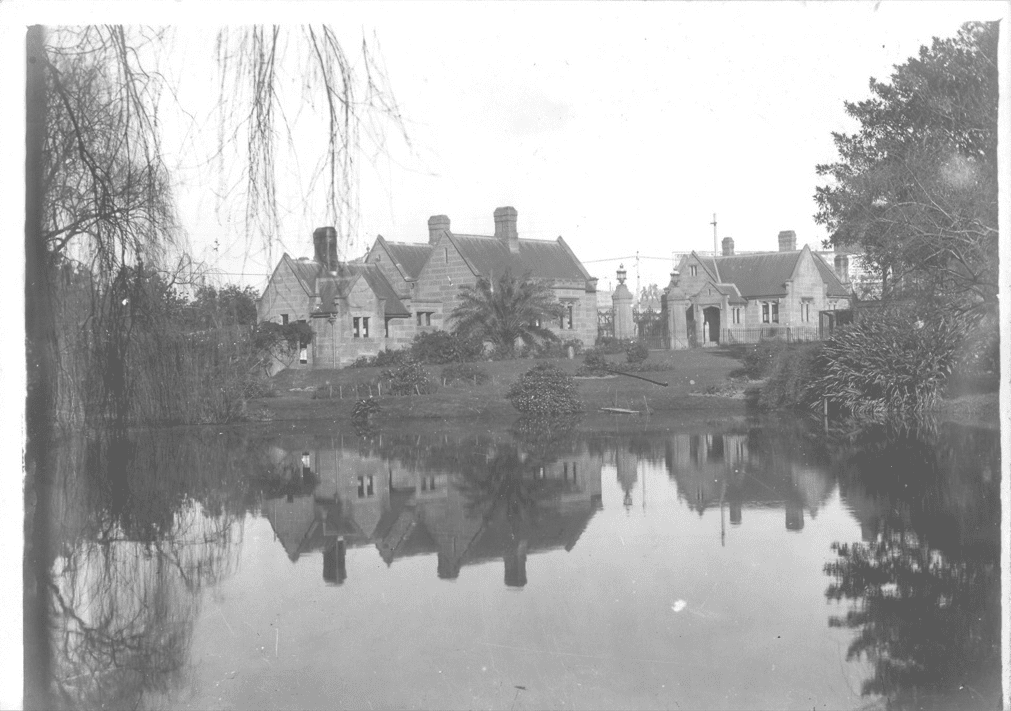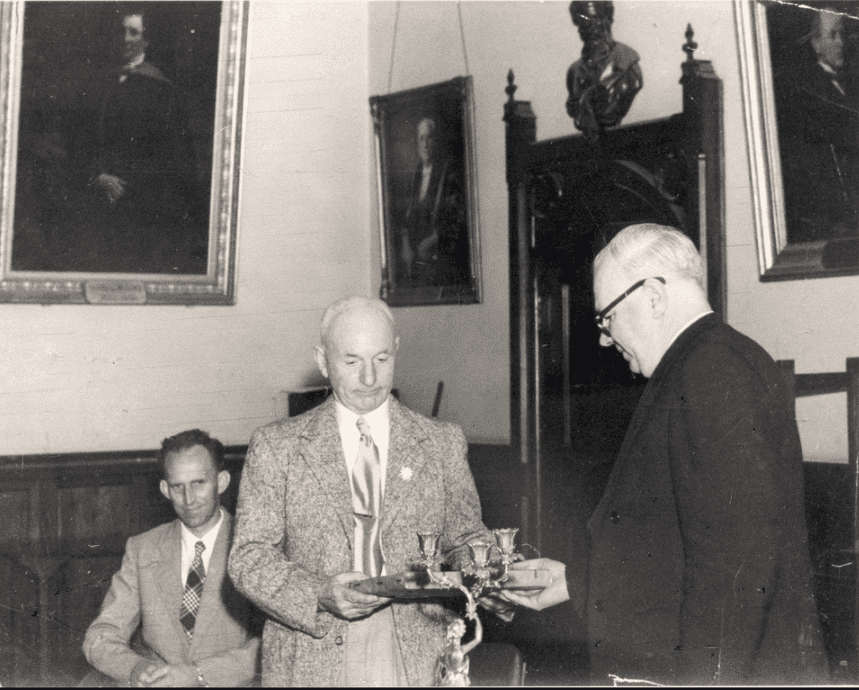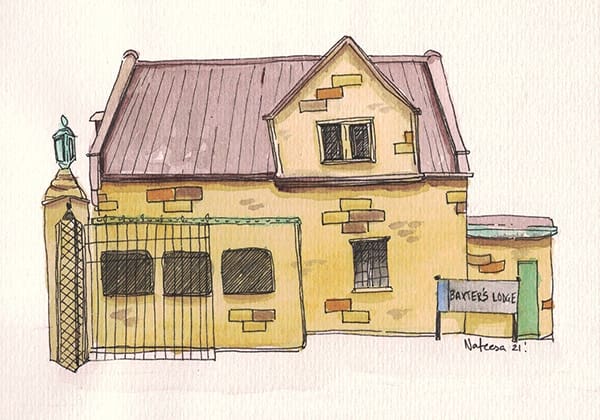On the corner of University Avenue and Parramatta Road, a quaint little cottage abuts the large, wrought iron gates. Students walk past it every day, ducking under the covered porch to shelter from the rain or sit on the sills and dangle their feet. This is Baxter’s Lodge, not so much a campus destination as a campus thoroughfare — taking a lot of the Glebe-bound foot traffic through its sandstone arches.
But while students, visitors and staff alike pass by it every day, not many people know why it’s there, or what it is, or even if anyone’s inside. To put it simply, Baxter’s Lodge is a knowledge drought in the campus consciousness, condemned to obscurity with little way out. That ends today!
Baxter’s Lodge was built between 1939 and 1940. Designed by Professor Leslie Wilkinson, the Lodge is a lot younger than one might think, as Wilkinson’s deceptively antique sandstone Gothic revival style tricks all who bear witness to it. When it was built, while slightly surprising, is a matter of settled fact, but how it was built is an issue of great debate. But to get into that debate, a morsel of context is required. Baxter’s Lodge, it may surprise you, isn’t the only lodge on campus. It is one of many. Previously, in what is now Victoria Park, there stood two sandstone cottages either side of the now disused grand entrance gates on City Road. On one side, Gardener’s Lodge, and on the other, Messenger’s Lodge (occasionally known as the Caretaker’s Lodge or the Attendant’s Lodge). As you might imagine, a gardener lived in one and a messenger lived in the other. These were both built between 1883 and 1885, but now…only one remains. In a 1924 land swap, the University gave up the northern range of Victoria Park (including Lake Northam and both lodges) in exchange for land where Fisher, New Law, and Carslaw now comfortably sit. As part of the agreement, the University could occupy Messenger’s Lodge for two years from the date of the agreement, and by mutual arrangement either lodge might be demolished. The glorious Messenger’s Lodge was demolished in 1939. A perhaps worse fate befell the Gardener’s Lodge, which, in the mid-1930s, was converted into ‘conveniences’ for local park patrons. That was a very nice way of saying public toilets.

Now we come to the hot button issue of the Baxter’s Lodge sandstone. One group says it was sourced from a demolished Messenger’s Lodge and another says “Well that’s really not possible.” Both arguments have merit. Analysis of the discoloration and aging of both stones suggest a third party was used for the construction of the Lodge. But, documents outline the University’s acquisition of the remnants of Messenger’s Lodge and their intention to “re-erect” the Lodge in another location. It’s a topic of much mystery though, as, after a November 13 1939 letter referencing the stones in question, their location was never recorded again. Are they holding up the roof of Baxter’s Lodge or are they lost in some dockside warehouse or University supply closet?
But whether it be old stone or new stone, the Lodge was built. Originally called the Yeoman Bedell’s Lodge, it was first built to house the University’s titular Yeoman. At the time of its completion, that was George Baxter. By all accounts, Baxter was a colourful campus character. In an interview he did for the Sydney Morning Herald in 1950, he describes in surprising detail how he “quelled” bigger men.
“I have a fairly good knowledge of ju-jitsu, you see. So if there’s any bother I just take ’em quietly aside for a little chat, and they realise it’s all over.”
Recounting his time keeping the peace on campus, Baxter paints a chaotic picture.
“I remember one young student, very important man now, he is well known to the public. Well, he came along to a Student Christian meeting, and pulled the carpet under a chap who was addressing the crowd.”
One eye on ‘em, one eye off ‘em. That was Baxter’s watchword.
And this wasn’t just self-important hot air. At a particularly rowdy 1941 meeting of the Labour Club, at which Baxter was himself an attendant and the events of which are recorded in Honi Soit, the crowd’s cheers and shouts ground to a halt as he rose from his seat.
“If I have to take names they will be of people I know. This won’t be pleasant,” Mr. Baxter bellowed, before concluding with an exasperated “Be quiet, will you.”
In his role as Yeoman Bedell and chief steward of the Union before that, George Baxter was a part of campus life: performing the ceremonial tasks demanded of his position and keeping students “in line” when frolicking turned into fracas.
So, it makes sense that Baxter would live at the University as well and the Lodge was the perfect place for him. He remained there until 1956, when he retired from his post and departed the University for good.

The occupants from 1956 till 1985 are a mystery, but it’s presumed that Baxter’s successor (A.J. Brook) and the Yeoman Bedells following him took up residence in the Lodge during their tenure. That mystery was broken in 1985, when the University’s supervisor of electrical works, Ted Lockwood, called the Lodge home until 1986. Sadly, this is where University Avenue’s homely cottage ceases to be a residence and assumes its new purpose as office space. The naughty nineties see the upstairs four poster beds broken down into firewood and, most likely, the HQ of the Chancellor’s Committee break through the front doors. Ever since, it’s been a revolving door of departments, subcommittees, institutes, offices, and your run-of-the-mill academic miscellania. Notable residents include the university accountant Michael Banningan in 1998, the Marketing team from 2002 to 2006, and the University’s videotape catalogue from around 2006 onwards. Today, it houses a think-tank: the National Center for Cultural Competence (the NCCC for short).
When you see the Lodge in person, it can be hard to imagine it as an office. With around 113.13 square meters of usable space, it is perhaps the second-smallest discrete academic space on campus — beaten for first by Science Road Cottage. Another entry in the university lodge genre, Science Road Cottage was originally built for a night watchman and at one point housed SRC offices. Today, it’s used by postgraduate science students as a research facility. But with an entire institute between its Pyrmont sandstone walls, what’s it like working in a space like Baxter’s?
“A lovely quaint space — but small!” said NCCC director and newly appointed Pro-Vice-Chancellor Indigenous (Academic) Professor Jennifer Barrett.
Quaint and small it is. Brass light switches litter each wall, the sandstone facade occasionally exposed in all its granular glory. The curved wall on the southern side used to be an enclosed courtyard, but it was capped off with a roof and converted into a conference room. There’s a lot of conversions which are eerie to think about. A bedroom in which George Baxter himself might have once slept is now an executive office. A kitchen in which his successor might have made Sunday roast is now the reception. Faint memories of a home linger, on the walls, in the space, and in the little details which have clung on.
This feeling is best encapsulated by the five carved shields which adorn its Parramatta Road facade, adjacent to the enclosed front garden. Wilkinson depicted the University’s faculties on them, pairing each one up with a complementary pair. Veterinary science with agriculture, medicine with dentistry. But while these pairings might make sense, the symbolism he chose to represent some of them baffles the mind. While sheep and horses for veterinary science are perfectly reasonable, an open book and a quill pen for dentistry is beyond the pale. Like Baxter’s Lodge, it makes very little sense: a Gothic sandstone cottage built 700 years too late, for a ceremonial office bearer whose purpose is nebulous at the best of times, now converted into offices, and perhaps built with missing, mystery stone.
The NCCC is relocating to another building in the next few weeks. Based on its historical inhabitants, it’s anyone’s guess who’s moving into Baxter’s Lodge. But whoever they are, I hope they appreciate the Lodge for what it is: a campus masterpiece.





